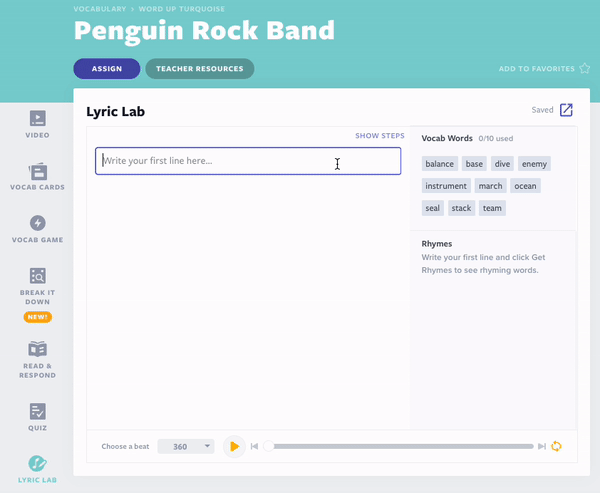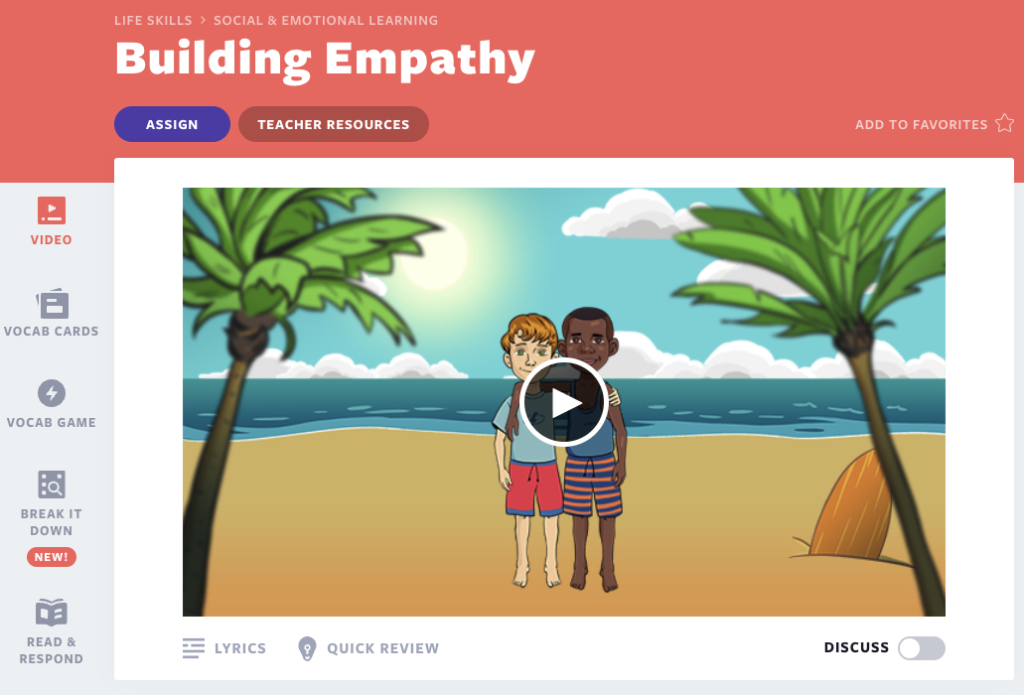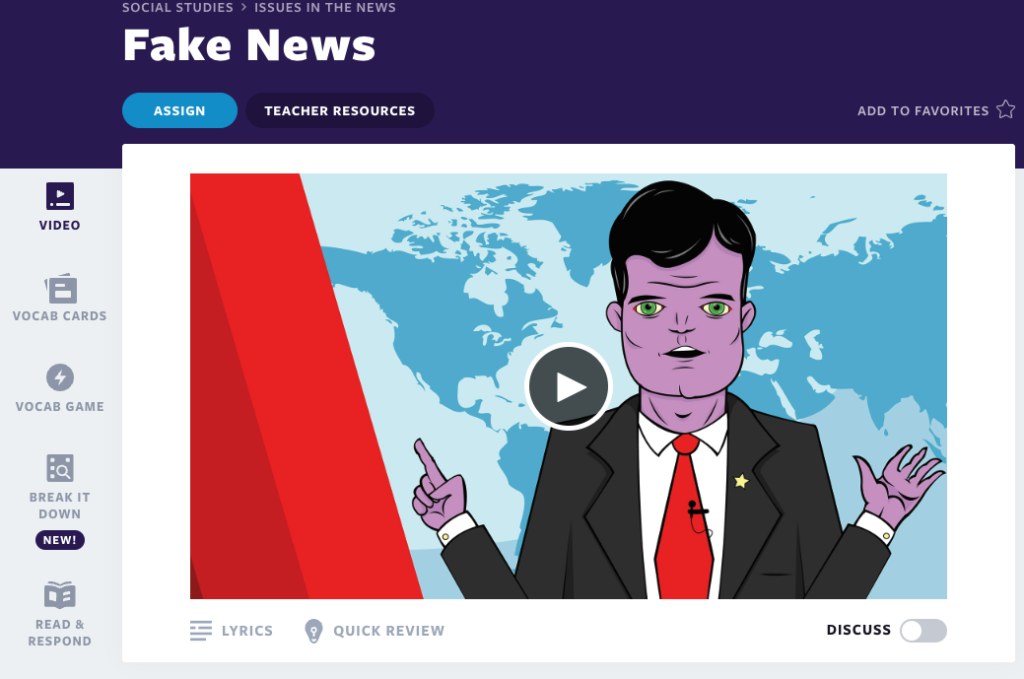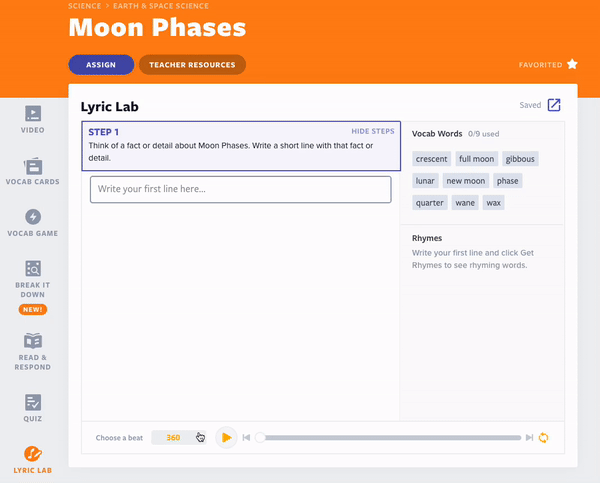
Advice from rappers on writing rhymes for rap lyrics and poems
In order to be a great rapper or poet, you have to have an understanding of writing rhymes. Mastering rhyme schemes and learning how to utilize slant and near rhymes comes with time and practice, and there are many ways to go about learning the skill. Whether you’re searching for poetry activities or learning how to write lyrics, this advice will be helpful for you and your students.
We’re exploring how different rappers go about writing their rhymes since the art of rhyming is so crucial to an emcee’s style. So we interviewed two of our own Flocabulary artists and broke down some bars formulaically. After the interview questions, explore our rhyme schemes guide to learn how to write a rhyming poem or song.
Captivate students and make learning experiences memorable and interesting through Flocabulary. Teachers can sign up below to access these activities and lessons, including Lyric Lab.. Administrators can contact us below to learn more about the power of Flocabulary Plus.
Advice from rappers on writing rhymes for rap lyrics and poems
Meet the rappers:

Dillon V., Recording Artist
“Write down your inspiration and your rhymes, because once those ideas leave, they don’t come back.”
– Dillon V.

Blake Harrison, Co-Founder and Rhyme Writer
“I try to write before thinking about it too much. I just take words from prose to poetry.”
– Blake Harrison
When you’re approached to write about a specific topic at Flocabulary, how do you begin your writing process?
Dillon responded: “Generally, I will look over the core concepts and the Common Core curriculum. There’s always a lot of information, and I use that as a starting point.
I think about how to make the information as fun and funky as possible, and before I get to the actual rhymes, I concept the song out. If I’m working on a history song, the concept is already there. And if the information is extremely dense, there isn’t a lot of room for a storyline or characters. But with a song like Area and Perimeter, there’s more freedom with characters.
Then I focus on a catchy hook. The verses are going to take a minute to memorize, so the hook should be fun. From there, I just write. Verse, hook, verse, hook.“
What’s one tip you would give to students who are just starting to write their own rhymes?
Dillon said: “Buy a composition book. Keep a physical rhyme book. That’s how I developed my process. If you’re just starting out, it’s important to have something physical, somewhere to go to put your ideas down. It’s also a reason for you to write and create. To this day, I write words that come to mind.
Write down your inspiration and your rhymes because once those ideas leave, they don’t come back. And write as much as you can. Be open to emotions and what’s around you. Don’t be afraid to be poetic. Rap can be about anything. It doesn’t have to be about girls or violence or success. So don’t put yourself in that box.
Also, listen to other music. Don’t just listen to rap. Expand your musical horizons.”
Is writing for Flocabulary similar to writing for yourself?
Dillon answered: “I would say the processes overlap. For both scenarios, I like writing rhymes to the beat.
When I started, I was really nerdy about it. I would try to say the biggest words or the most syllables. Over time, my musical style has simplified. I’m trying to do more with less.
I’m a sucker for internal rhymes and more complex rhyme schemes. I put more of those in my personal stuff. Academic rap has to be accurate and factual. You have to make concessions sometimes. The best rhyme might not be the simplest way to explain something, so it gets tricky. There’s no room for extraneous words.”
What is your writing process like?

Blake responded: “I like to write over a beat. The two most important things with Flocab songs are the information you must include and the beat. Even if it isn’t the beat we end up using, something with the general mood of the song is important.
I basically try to write before thinking about it too much. I just take the sentences from prose to poetry. This is the most literal approach and doesn’t result in the best work, but it is the best way to get started.
Then I really write poetry from line to line. I think of the facts I have to put in there and put a ton of different words in the end rhyme position to see what makes the most sense.”
What advice would you give to beginners writing rhymes?
Blake said: “There are techniques and creative processes that work for some people but aren’t helpful for others. And, like everything, you have to learn the basic rules, then you learn to break those rules.
So start simple. Then take those lyrics and ask yourself, “What could I add to this to make it more interesting?”
What tips or tricks do you have for students writing their own rap lyrics or poems?
- Don’t seek perfection, especially when you’re just starting out.
- Emphasis is important and can be used to make your rhymes more interesting.
- Usually, when I’m writing, I’ll talk under my breath. I have to have my mouth move in order to feel the rhythm. It’s the best way to feel the beat.
- Don’t be afraid of imitation. Find your favorite hip-hop rapper, and try to write a similar scheme in your own words. It’s okay to copy their flow at first.
How to write a rhyming poem
In order to write complex rhyme schemes, you must understand the basics. A rhyme scheme is a pattern of rhymes in a series of lines or bars. Simply put, it’s where you choose to put your rhyming words!
A bar is a collection of four beats. Your rhymes can come directly on the beat or they can be syncopated, which means slightly off-beat or displaced. Syncopation relies on a steady, established pulse underneath it. Learn the following types of rhyme schemes to master how to write a poem rhyme.
A/A, B/B

The simplest writing rhyme scheme is one where the rhyme is placed at the end of the bar or the last beat. This is the easiest rhyme scheme to drop and usually follows the A/A, B/B formula like these lyrics from Building Empathy:
“Let me tell you about the time,
I was hanging out with a friend of mine”

To make your lines a little more complex, you can place a third rhyme in the middle of one of the bars or on the second beat. This makes your rap a little more intriguing because it adds more detail to listen to. It’ll look something like these lyrics from Fake News:
“Extra, extra check out the news,
But be sure what you choose is verifiable and true“
Slant rhyming
Now let’s add one more layer of difficulty. For this next rhyme scheme, place your first rhyme on the second beat of the first bar, then put your second rhyme on the last beat of the second bar. This rhyme scheme is powerful, shows you understand complicated rhyme schemes, and leads to a powerful build-up in the song.
Let’s get formulaic with it to learn how to write a rhyming poem. Below, the beats are marked with numbers, and the “A” is used to represent the rhyming words you’re placing on the beat:
“1, A, 3, 4
1, 2, 3, A”
Here’s an example of rhyming poetry from Planets:
“AKA life, air, and water are things that make it
Let’s hop inside my spaceship and travel afar.”
You’ll notice that the words “water” and “afar” aren’t perfect rhymes. In both rap and poetry, imperfect, slant, and near rhymes are used in order for the artist to have more freedom.
Rhyme schemes are pretty universal in rap music. You can find these rhyme schemes in all your favorite songs. Many artists think of their rhymes formulaically to create unique poems, similar to how we broke down that last rhyme scheme. Rakim likes to start off with 16 dots on a paper to mimic a 16-bar line. He visualizes a graph between the bars in order to fit words and syllables inside. Eminem likes to think of words as puzzles as he tries to fit words in the lines.
How to do upbeats
Next, we’re going to introduce the upbeat. Try tapping your foot and counting four beats. Do it again, but every time you bring your foot up, say “and.” Your foot should fall on the beat and rise on the “and.”
With the upbeat, the formula above would look like this:
“1-, A-, 3-, 4-
1-, 2-, 3-, A-“
The numbers represent your downbeat when your foot touches the ground, and the hyphens represent your upbeat, or when your foot is in the air. We’re marking our rhymes with letters still, just like an AA/BB formula. Whenever we introduce a new rhyme, we’ll use a different letter.
Now let’s use our formula to decipher the writing rhyme scheme of “Slide Show” by T.I:
“Refuse to give up your mistakes will define you
Down dictate where you heading then remind you
That time keeps ticking let your mind keep clicking
Never stop thinking be aware of your decisions.”
Listen to the verse a few times to establish the beat. You’ll notice that naturally, your foot, or the downbeat, will fall on the second syllable of “Refuse.” From there, the pattern is relatively easy to mark. Because we’re looking at four lines, the rhyme scheme will seem more complicated.
“-1, -2, -A, -BC
1, -A, -D, -BC
-B, ED, -B, ED
F, -D, -F, -D”
If this approach doesn’t work for you, don’t worry! Lots of rappers let their rhymes flow naturally.
Practice writing rhymes with Flocabulary’s Lyric Lab
Itching to get more analytic and strategic with your rhyme writing? Use Flocabulary’s Lyric Lab as poem maker to practice your rhyme writing—it’s available on every Flocabulary unit.

Students start their own rap poems by choosing an instrumental and writing a line about the content they’ve learned. A word bank is located on the right-hand side of Lyric Lab, where students are reminded to include the vocabulary words in their creations. With our rhyme generator, you don’t need a rhyming dictionary! Every time a new line begins, an additional word bank filled with words that rhyme with the last word of the previous line populates to support the student creation process. Once the rap is completed, teachers and students can export their lyrics onto print or PDF. Students can also select a beat within the Lyric Lab to perform their song.
Captivate students and make learning experiences memorable and interesting through Flocabulary. Teachers can sign up below to access these activities and lessons, including Lyric Lab.. Administrators can contact us below to learn more about the power of Flocabulary Plus.
